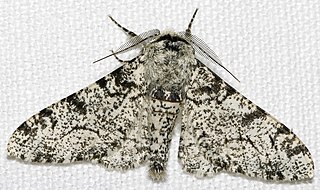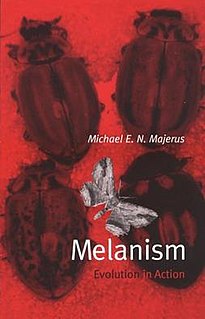
The peppered moth is a temperate species of night-flying moth. It is mostly found in the northern hemisphere in places like Asia, Europe and North America. Peppered moth evolution is an example of population genetics and natural selection.

Lamarckism, also known as Lamarckian inheritance or neo-Lamarckism, is the notion that an organism can pass on to its offspring physical characteristics that the parent organism acquired through use or disuse during its lifetime. It is also called the inheritance of acquired characteristics or more recently soft inheritance. The idea is named after the French zoologist Jean-Baptiste Lamarck (1744–1829), who incorporated the classical era theory of soft inheritance into his theory of evolution as a supplement to his concept of orthogenesis, a drive towards complexity.

Edmund Brisco "Henry" Ford was a British ecological geneticist. He was a leader among those British biologists who investigated the role of natural selection in nature. As a schoolboy Ford became interested in lepidoptera, the group of insects which includes butterflies and moths. He went on to study the genetics of natural populations, and invented the field of ecological genetics. Ford was awarded the Royal Society's Darwin Medal in 1954.

Henry Bernard Davis Kettlewell was a British geneticist, lepidopterist and medical doctor, who performed research on the influence of industrial melanism on peppered moth coloration, showing why moths are darker in polluted areas. This experiment is cited as a classic demonstration of natural selection in action. After live video record of the experiment with Niko Tinbergen, Sewall Wright called the study as "the clearest case in which a conspicuous evolutionary process has actually been observed."
Michael Eugene Nicolas Majerus was a British geneticist and professor of evolution at the University of Cambridge. He was also a teaching fellow at Clare College, Cambridge. He was an enthusiast in Darwin's theory of evolution by natural selection and became a world authority in his field of insect evolutionary biology. He was widely noted for his work on moths and ladybirds and as an advocate of the science of evolution. He was also an enthusiastic educator and the author of several books on insects, evolution and sexual reproduction. He is best remembered as an ardent supporter and champion of experiments on peppered moth evolution.

The evolution of the peppered moth is an evolutionary instance of directional colour change in the moth population as a consequence of air pollution during the Industrial Revolution. The frequency of dark-coloured moths increased at that time, an example of industrial melanism. Later, when pollution was reduced, the light-coloured form again predominated. Industrial melanism in the peppered moth was an early test of Charles Darwin's natural selection in action, and remains as a classic example in the teaching of evolution. In 1978 Sewall Wright described it as "the clearest case in which a conspicuous evolutionary process has actually been observed."
Bruce S. Grant is emeritus professor of biology at the College of William and Mary. He has a particular research interest in the peppered moth, He is a defender of the teaching of evolution and has criticized creationist Jonathan Wells, who has cited his work, as "dishonest."
The Evolution of Melanism: a study of recurring necessity; with special reference to industrial melanism in the Lepidoptera is a 1973 science book by the lepidopterist Bernard Kettlewell.

Melanism: Evolution in Action (ISBN 0-19-854982-2) is a book by Dr. Mike Majerus, published in 1998. It is an update of Bernard Kettlewell's book The Evolution of Melanism.

The term melanism refers to black pigment and is derived from the Greek: μελανός. Melanism is the increased development of the dark-colored pigment melanin in the skin or hair.

James William Tutt was an English schoolteacher and entomologist. He was a founding editor of the journal Entomologists' Record from 1890 and published a landmark series on the British Lepidoptera in which he described numerous species of moths and was among the first to notice industrial melanism in the pepper moth Biston betularia and was among the first to provide a clear explanation of their increasing frequency based on the role of crypsis, natural selection by predators, and the effect of changed environmental conditions brought on by industrialism.
Niche microdifferentiation is the process a species undergoes to reach genetic diversity within that species; it is the process by which an ecotype is created. This process is regulated by various environmental influences whether they be morphological, spatial, and/or temporal. This means that a trait of one organism in one area is not advantageous for the same species in a different location: "the trait that alters the environment in a manner that is favorable to growth tends to be reinforced and this positive feedback can further, to a certain extent, modify the selection pressure on itself". For example, a species of moth which is white and lives in an area where tree bark is stripped and tree color is white will more easily survive than a white moth in a different location where trees are moss-covered and green. This leads to adaptations that allow the species to exist in a slightly different environment. Organisms within the same species can undergo phenotypic and genotypic changes due to niche microdifferentiation. Conspecific organisms can vary in color, size, diet, behavior, and morphology due to differences in environmental pressures. Related topics include epigenetics, niche differentiation, and evolutionary biology.

Industrial melanism is an evolutionary effect prominent in several arthropods, where dark pigmentation (melanism) has evolved in an environment affected by industrial pollution, including sulphur dioxide gas and dark soot deposits. Sulphur dioxide kills lichens, leaving tree bark bare where in clean areas it is boldly patterned, while soot darkens bark and other surfaces. Darker pigmented individuals have a higher fitness in those areas as their camouflage matches the polluted background better; they are thus favoured by natural selection. This change, extensively studied by Bernard Kettlewell, is a popular teaching example in Darwinian evolution, providing evidence for natural selection. Kettlewell's results have been challenged by zoologists, creationists and the journalist Judith Hooper, but later researchers have upheld Kettlewell's findings.

Kettlewell's experiment was a biological experiment in the mid-1950s to study the evolutionary mechanism of industrial melanism in the peppered moth. It was executed by Bernard Kettlewell, working as a research fellow in the Department of Zoology, University of Oxford. He was investigating the cause of the appearance of dark-coloured moth since Industrial Revolution in England in the 19th century. He conducted his first experiment in 1953 in the polluted woodland of Birmingham, and his second experiment in 1955 in Birmingham as well as in the clean woods of Dorset.
Judith Hooper is an American journalist.

Biston strataria, the oak beauty, is a moth of the family Geometridae. It is native to Europe, the Balkan countries and the Black Sea region as far as Asia Minor and the Caucasus. The species was first described by Johann Siegfried Hufnagel in 1767. B. strataria is found in a variety of habitats, but is mostly found in woodlands where it rests on the bark of trees, camouflaged by its mottled black and grey wings. The male has feather-like antennae while those of the female are more thread-like. The moth has a wingspan of 40 to 56 mm.
Helen Spurway was a British biologist and the second wife of J. B. S. Haldane. She emigrated to India in 1957 along with Haldane and conducted research in field biology along with Krishna Dronamraju, Suresh Jayakar, and others.
Many types of polymorphism can be seen in the insect order Lepidoptera. Polymorphism is appearance of forms or "morphs" differing in colour and number of attributes within a single species. In Lepidoptera, polymorphism can be seen not only between individuals in a population, but also between the sexes as sexual dimorphism, between geographically separated populations in geographical polymorphism and also between generations flying at different seasons of the year. It also includes the phenomenon of mimicry when mimetic morphs fly alongside non-mimetic morphs in a population of a particular species. Polymorphism occurs both at specific level with heritable variation in the overall morphological design of individuals as well as in certain specific morphological or physiological traits within a species.

Animal coloration provided important early evidence for evolution by natural selection, at a time when little direct evidence was available. Three major functions of coloration were discovered in the second half of the 19th century, and subsequently used as evidence of selection: camouflage ; mimicry, both Batesian and Müllerian; and aposematism.












